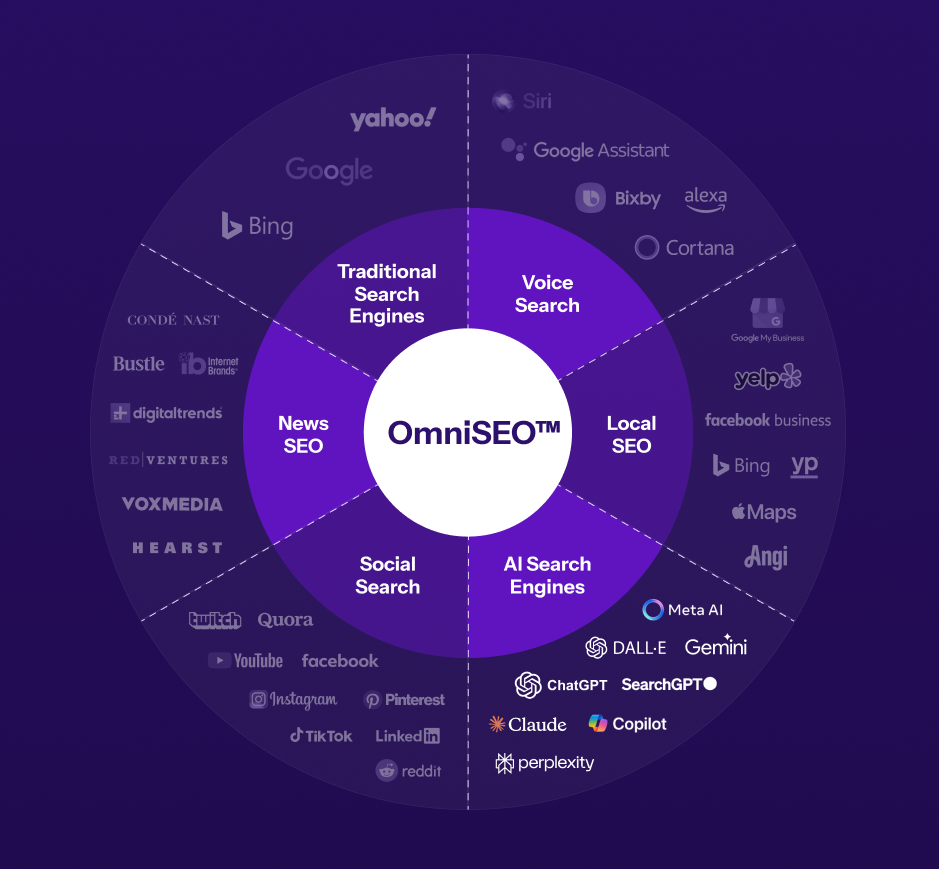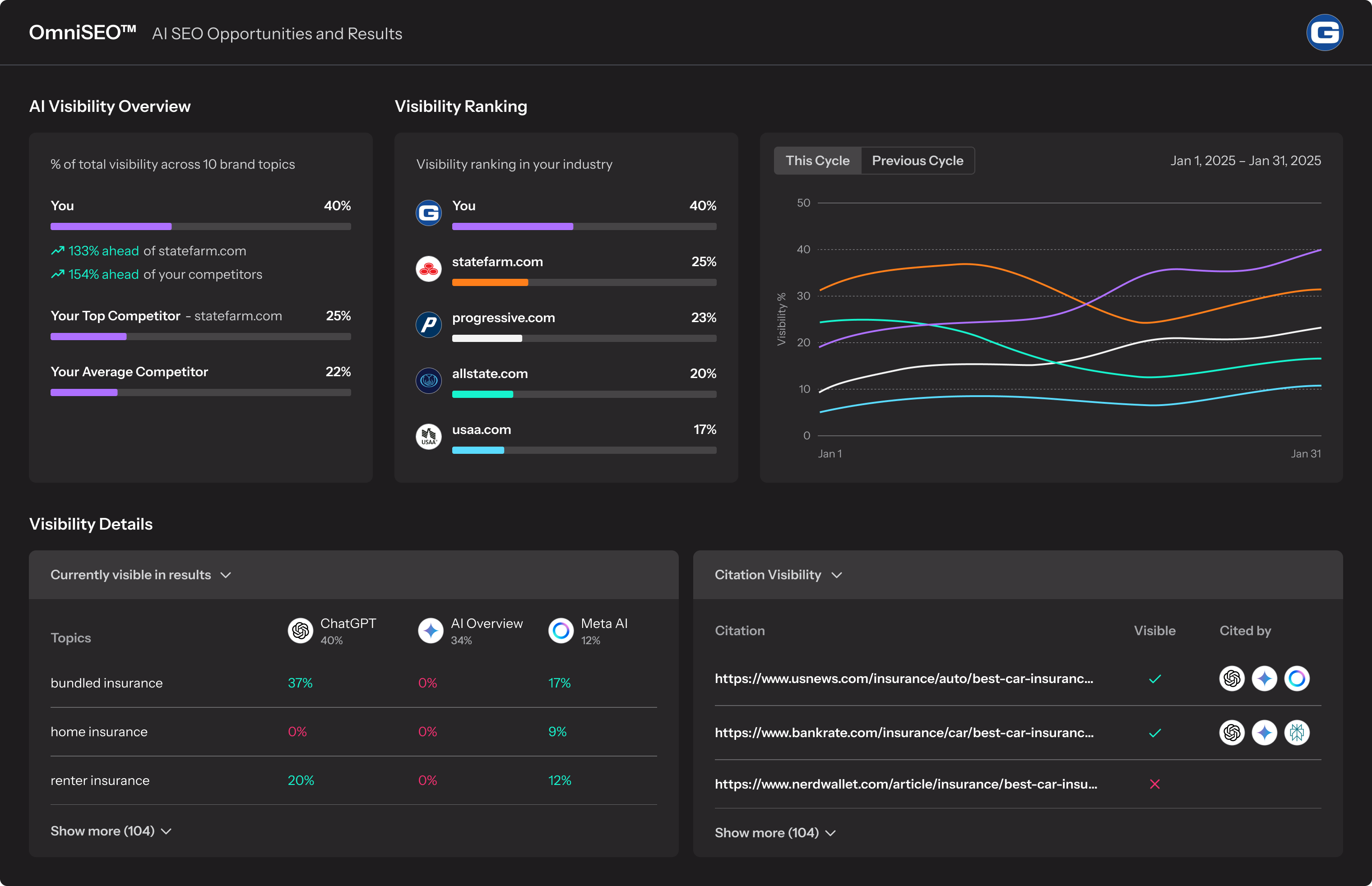How to use this guide
Use this guide to meet your unique needs, whether it’s learning:
- What search everywhere optimization is
- Whether traditional SEO is dead
- Who should optimize for it
- How search everywhere optimization works (and how to measure it)
- And more
Learning the basics
Learn the basics of search everywhere optimization now:
What is search everywhere optimization?
Search everywhere optimization — also known as OmniSEO™ — is the process of optimizing a brand’s visibility across search experiences, both traditional and generative, to build brand awareness, generate website traffic, and nurture conversions.
Is search everywhere optimization a fad?
It’s natural to question search everywhere optimization — after all, voice search optimization has been called the next big thing for years. However, the data points in a different direction for search everywhere optimization:
- 1 in 10 U.S. Internet users now use generative AI first for an online search (Source)
- ChatGPT has 800 million weekly active users (Source)
- 400+ million people use Meta AI each month (Source)
- 10+ million people use Perplexity AI each month (Source)
- Organic search engines, from Google to DuckDuckGo, have declined in traffic (Source)
- ChatGPT is one of the Top 10 visited websites in the world (Source)
Search behavior is changing, and if businesses want to get discovered online, they’ll need to expand their optimization efforts across platforms, from social media networks to search engines to review sites.
What search experiences does search everywhere optimization include?

Search everywhere optimization spans several search experiences:
| Experience | Examples |
| Search engines |
|
| Generative engines |
|
| Social networks |
|
| Media networks |
|
| Local listings |
|
| Voice assistants |
|
What are some examples of search everywhere optimization?
Some examples of search everywhere optimization (that our team has worked on) include:
| Industry | Optimization | Result |
| SaaS |
|
Citations in Perplexity, DuckDuckGo, and Copilot |
| Professional services |
|
Citations and mentions in AI Overviews, Perplexity, Copilot, and others |
| Utilities |
|
Mentions in Copilot and Perplexity |
What is the difference between search everywhere optimization and search engine optimization?
The differences between search everywhere optimization and search engine optimization include:
| Area | Search everywhere optimization | Search engine optimization |
| Search experiences | Focused on 30+ search experiences on social, generative AI platforms, and more | Focused on search engines (primarily Google) |
| Metrics |
|
|
| Targeting |
|
|
Even with these differences, the two cross over when it comes to optimization tactics. Both, for example, focus on producing unique and authoritative content that gets shared online.
Is SEO dead?
SEO isn’t dead.
Our firsthand experience practicing search everywhere optimization has shown that traditional SEO is a critical part of search everywhere optimization. Sites practicing good SEO are more likely to appear across search experiences.
That’s because traditional — or core SEO — supports:
- Being discoverable online
- Producing helpful and unique content
- Building a trusted online reputation
While SEO isn’t dead, it is challenging marketers to reframe its value to leadership.
Across industries, businesses are seeing a decline in organic search traffic, with Gartner predicting that sites will lose 25% of their organic traffic to AI-powered platforms and experiences like ChatGPT, Perplexity AI, and Meta AI.
At the same time, companies are seeing an increase in revenue, indicating that user journeys are happening across platforms, from search engines to AI tools to social media networks, and that marketers need to adapt their approach to SEO.
Who should practice search everywhere optimization?
Everyone!
While search engines like Google aren’t going away, they are adapting their search experiences. Google, for instance, has launched AI Overviews to provide AI-generated summaries in search results (and has seen an increase in search usage from it).

In comparison, Meta launched Meta AI for its social networks, Facebook, Instagram, and WhatsApp. The company has also partnered with Ray-Ban to produce smart glasses, which have beaten internal sales and revenue targets.

It’s important to acknowledge that search everywhere optimization requires more time, skill, and resources than traditional SEO. For small businesses, that’s a big lift, which can make starting with core SEO — and then adding search everywhere optimization later — more feasible.
Getting started
Learn how to start practicing search everywhere optimization now:
What are the challenges of search everywhere optimization?
Before setting goals, planning optimizations, and measuring progress, understand that search everywhere optimization isn’t perfect — there are pieces to it that will make your job more challenging, including:
Reporting
Reporting is one of the most significant challenges of search everywhere optimization. Without data, it’s difficult to prove the value of these optimizations to leadership, which can affect allocated budget and resources.
In most cases, businesses have to pull numbers manually.
For example, we’ve seen companies track their mentions in generative AI experiences via a Microsoft Excel or Google Sheet. That’s a time-consuming process and misuses your team’s talents.
What alternative do businesses have, though? Almost none, unfortunately.

One of the few platforms available for tracking search everywhere optimization performance is the OmniSEO platform. This platform allows businesses to target, track, and optimize for specific phrases across search experiences like:
- Google’s AI Overviews
- ChatGPT
- Microsoft Copilot
- Perplexity AI
- Apple Intelligence
- Meta AI
- And more
With its automated data collection (plus competitor tracking), businesses can focus more on optimizing and data analysis and less on data collection and management.
Companies can also access search everywhere optimization support if needed through the platform. The OmniSEO platform requires a paid plan, though, so if another tool isn’t in your budget, plan to track performance manually.
Buy-in
Asking leadership for the budget and resources to invest in SEO, plus search everywhere optimization, is not the easiest conversation, especially since search everywhere optimization is a newer development.
However, the data is there to demonstrate that search is changing:
- 73% of consumers use multiple channels to shop (Source)
- 67% of users use social media to discover new brands (Source)
- 58% of consumers have replaced traditional search engines with AI platforms (Source)
- 35% of Amazon purchases come from AI-based product recommendations (Source)
One option for presenting search everywhere optimization is to suggest the 70-20-10 rule:
- 70, where 70% of resources go to what’s working well now.
- 20, where 20% of resources go to what’s upcoming and expected to work well.
- 10, where 10% of resources go to what’s new and experimental.
You could present allocating 20% — or 10%, depending on your audience — of resources toward search everywhere optimization. The strategy is new, but also has solid data demonstrating its value and effectiveness.
Resources
Resources are another pain point for adopting search everywhere optimization and can include:
- Time
- Talent
- Tools
- Budget
While some of these are easier to solve than others, like hiring a marketing agency vs. requesting more budget, researching these problems and realistic options for solving them is worth your time.
For example, is it worth reducing investments in a lower-performing strategy to do search everywhere optimization? Or, could someone spend a few hours less each week on specific tasks to support everywhere optimizations?
Do your research and consider the pros and cons of these different decisions.
How does search everywhere optimization work?
How search everywhere optimization works depends on the following:
- Search experience, like AI Overviews vs. ChatGPT
- Targeted search, like an informational or transactional query
- Search platform, like social media vs. search engine
For example, if targeting a more transactional question, like “what are some affordable car insurance companies,” your optimizations might focus more on getting mentioned by third-party sites.

In comparison, optimizations for an informational question, like “how to choose car insurance coverage,” might focus more on producing or optimizing existing content on your website for this topic.

Learn more about specific optimizations in the walk-through below!
How much does practicing search everywhere optimization cost?
Pricing for search everywhere optimization services isn’t as established as traditional SEO, which costs $1,500 to $5,000 per month. However, companies offering these solutions usually charge a few thousand dollars per month.
If considering these services, we recommend researching the provider’s experience, past work, and reviews beforehand. Ask for a list of expected deliverables, too, to understand what you’ll receive — and how much it’ll cost.
How to get started with search everywhere optimization
Learn how to get started with search everywhere optimization in three stages:
How to build a strategy
Building a strategy for search everywhere optimization is similar to other digital marketing efforts, like search engine optimization, email marketing, or social media marketing. You want to work with stakeholders to understand:
- How much budget, time, and resources are available
- Which metrics will measure performance (and success)
- When to evaluate performance and re-evaluate investment
- Which tasks and tools to prioritize and use
In our experience, the most common mistake businesses make when strategizing for search everywhere optimization is to expect too much, too soon in results. Similar to search engine optimization, search everywhere optimization takes time.
It’s also a strategy that focuses on creating touchpoints throughout the user journey — unlike paid advertising, which focuses on reaching users who are almost ready or completely ready to make a purchase decision.
Here is an example strategy:
- How much budget, time, and resources are available
- Budget: 10% of budget
- Time: 4 hours per week
- Resources: Existing tech stack
- Which metrics will measure performance (and success)
- Citations and/or mentions for these phrases: X, Y, and Z
- When to evaluate performance and re-evaluate investment
- Performance: 3 months
- Investment: 8 months
- Which tasks and tools to prioritize and use
- Tasks: Targeted search research, Content creation
- Tools: Existing tech stack, including Microsoft Excel for performance tracking
Work with your team to create a strategy for your organization — and be flexible! Strategies can change in response to what’s working (and what isn’t), so don’t feel committed to seeing an approach through.
You can also explore using AI in digital marketing to maximize your marketing efforts.
How to optimize visibility
The most effective optimizations for improving visibility across search experiences are:
| Optimization | Tactics |
| Produce compelling content |
|
| Build a reputable brand online |
|
| Practice search engine optimization |
|
Learn more: How to Rank on Answer Engines
How to measure success
When it comes to measuring success, there are two parts:
- Choosing which metrics to measure
- Choosing how to measure those metrics
The most common metrics for search everywhere optimization include:
| Metric | Meaning | How to measure |
| Citations | A search experience links to a website |
|
| Mentions | A brand is mentioned in a search experience |
|
| Placement | A brand’s placement in a search experience’s response (ie. First, second, etc.) |
|
| Referral traffic | The traffic referred to a site from another site, like chatgpt.com |
|
| Conversions | The conversions generated — directly or indirectly — by a search experience |
|
While some of the traffic options depend on a business’s tech stack, it’s common for most companies to use Google Analytics 4. If that’s the case for your organization, set up a new custom channel group for segmenting referral traffic into two groups:
- Traditional referral traffic, like for traffic earned through traditional SEO backlinks.
- Search everywhere referral traffic, like for ChatGPT, Perplexity, and Copilot traffic.
This update will make measuring search everywhere traffic easier and faster.
To start your new SEO journey, complete these three steps: Strategize, optimize, and measure.
Get discovered everywhere in SEO’s new era
Congrats! You’ve learned all about SEO’s new era. Now, get discovered across search experiences, from Google to Meta AI to ChatGPT, with search everywhere optimization.
For professional help (or a demo of our OmniSEO platform), contact us online!
Table of Contents
- How to Use This Guide
- Learning the Basics
- What is Search Everywhere Optimization?
- Is Search Everywhere Optimization a Fad?
- What Search Experiences Does Search Everywhere Optimization Include?
- What Are Some Examples of Search Everywhere Optimization?
- What is the Difference Between Search Everywhere Optimization and Search Engine Optimization?
- Is SEO Dead?
- Who Should Practice Search Everywhere Optimization?
- Getting Started
- What Are the Challenges of Search Everywhere Optimization?
- How Does Search Everywhere Optimization Work?
- How Much Does Practicing Search Everywhere Optimization Cost?
- How to Get Started with Search Everywhere Optimization
- Get Discovered Everywhere in SEO’s New Era
Related Resources
- How to Appear in ChatGPT Answers: a Guide for Businesses
- How to Rank on Answer Engines: 7 Most Effective Tactics
- How to Use AI in Digital Marketing: Maximize Your Marketing Efforts
- Measuring Success in Omnichannel SEO
- Meta AI for Business: Understanding Meta Business AI Tools
- OmniSEO™ – Rank Everywhere
- Perplexity and AI SEO: How to Rank in Perplexity Answers
- What is Answer Engine Optimization? The SEO’s Guide to AEO
- What is Generative Engine Optimization (GEO)?
Writers


Meet
The top digital marketing company behind SEO.com.
Ready to get results? Connect with us, today!

